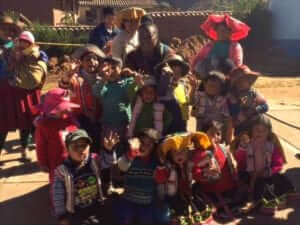Jada Thomas is a special education teacher at Fairfax County Public Schools. Having completed her Year-Long Certification with Mindful Schools, Jada uses mindfulness both within and outside of the classroom to improve her teaching practice.
I started on my path to mindfulness doing yoga at the insistence of my mother and my life coach—I’ve always struggled with depression, and it’s something I have to work to keep in check. At the same time, they were pushing me into meditation and I just remember thinking, “I can’t do that. I can’t sit for a second without my mind going all over the place.” But, as I started getting more into yoga, I started becoming more attracted to meditation.

I continued doing meditation on my own and began noticing changes in my stress level—how I responded to issues in my life—both personally and professionally. My life was far from perfect and I still battled with depression, but it wasn’t as intense as before. Previously, I would go to a class and think, “I can’t do this.” Or, I would try meditation on my own and think, “This isn’t for me.” I guess maybe at that point I wasn’t ready for it—I feel like things come into your life when you’re ready for them and you’re ready to accept it.
So, I started doing yoga with my students. One day, I had an empty block in my class so I thought, “You know what? Let’s just move the tables and the chairs out of the way and pull up a yoga video.” Our kids have a wide range of disabilities—most of the kids were open to it [and] they loved it, so it became a part of our routine.
Later, I Googled “meditation with kids” and found Mindful Schools. I took the introduction to the mindfulness course and thought, “This is it.” So, I started using the curriculum with the students and applied for the school’s year-long program.
One of the core principles of the program is that through practicing mindfulness, you can become a better teacher. I would say [mindfulness] is simply taking a moment to be present and aware, but from a neutral base—not being judgmental, not putting yourself down. Personally, it’s allowed me to delve further into myself and work out some of the things that may have been preventing me from showing up fully in the classroom. I used to show up at maybe 30-40% because I was just so consumed by everything that was going on.
You know, for most teachers, self-care really isn’t on the list because there’s just no time for it. It’s the nature of our profession—you’re giving and giving and you’re never replenishing anything. But, when you sit down to practice mindfulness, that’s a moment that you’re taking for yourself to help replenish everything you give.
Things still happened in my life. Last year, I probably had one of the most challenging classes that I’ve ever had. But, I look at it as a lesson because I was able to practice mindfulness with that group of students and really see it work. I had a student last year that had some really severe behavior—we implemented mindfulness strategies with her, and it really helped her. She was able to use that strategy to regulate her emotions and to help her understand what her body feels like when she’s about to melt down and what she can do to prevent that.
I feel like a lot of times in education, when there’s a new strategy or technique, it’s usually tested first on the general education population. Then, it gets to special education whenever it’s convenient. But, I think with mindfulness, these students absolutely should be the first population that we’re working with. These are students that have severe issues with regulating their emotions—for a lot of our kids, this is the crux of their issues. Mindfulness gives them a self-esteem boost because they have a strategy to use to control their emotions—it helps them stay focused and stay calm. That’s huge for a kid who may have a lot of issues with that.
We had a situation with a student last year—her sister was having a baby, and she was very anxious about the baby coming into the home. This is a student with autism who is used to routine and knowing what’s going to come next. With that baby, she just didn’t know. She was upset and having a lot of breakdowns throughout the day, so I said, “Why don’t we just take some time and do some deep breathing?” We sat in the break-room, did maybe 3-5 minutes of a guided body scan meditation, and she was able to bring herself down—to get to a level where she was calm and able to talk about things.
With my students, I use the Mindful Schools curriculum. We start by talking about how to have a mindful body when you’re getting into your practice, mindful breathing, mindful listening. Then, embedded within each lesson is time to practice breathing meditation. Each lesson builds, so you start with just one minute of breathing and work your way up to 15 minutes. For students who might need a little extra time and practice, we have a support group in the morning.
Mindfulness in itself is very abstract, so just explaining it to them, that’s probably the hardest part. But, once they understand it and they see the impact, we’re full speed ahead. You know, I look at these kids who struggle with basic skills—communication skills, social skills—and it’s absolutely amazing because they understand mindfulness and they understand when to use it.
Below, Jada offers her tips for introducing mindfulness to students, and learning mindfulness with other teachers:
- Start by saying to the students, “I want to introduce something to you that can help with dealing with your stress levels, with different emotions, with anger—just helping you be in control a little bit more.”
- There are lots of different guided apps out there. The Calm app is a great app to use with students in a group setting—it’s free and provides guided meditations. It also tracks your meditation sessions.
- Everyone in my cohort—they were all still teachers. We even had a couple of people who were starting schools. So, they were a tremendous help. Our program gave out a lot of information, which could be overwhelming at times. But, I was able to talk to my teachers and just say, “I’m struggling with this,” and because these people know exactly what I was going through, they were able to help me out. They’re kind of like your family and your support group.
Jada’s story originally appeared on Teacher2Teacher and is reposted with permission.
Mindful Schools transforms school communities from the inside out. Founded in 2007, Mindful Schools’ graduates have impacted over 750,000 children worldwide. You can learn more about our online course offerings, Mindfulness Fundamentals and Mindful Educator Essentials, and our Advanced Courses at mindfulschools.org.
